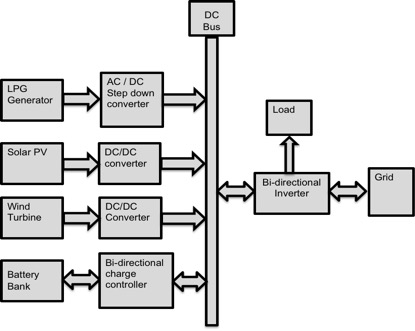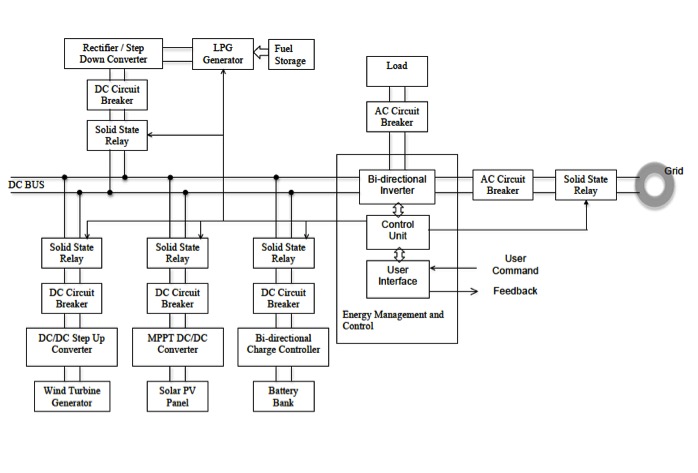Difference between revisions of "Projects:2018s1-180 Development and Control of a Standalone Power Source for Residential Dwellings and Small Businesses"
| (15 intermediate revisions by the same user not shown) | |||
| Line 1: | Line 1: | ||
| + | |||
| + | == Content == | ||
1.Introduction | 1.Introduction | ||
| − | |||
| − | |||
| − | |||
| + | :1.1 Motivation and Aim | ||
| + | |||
| + | :1.2 Background | ||
| + | |||
| + | 2. Hybrid system configuration | ||
| + | |||
| + | 3. System at a glance | ||
| + | |||
| + | :3.1 Features | ||
| + | |||
| + | 4. Conclusion | ||
| + | |||
| + | 5. Members | ||
| + | |||
| + | :5.1 Group Members | ||
| + | |||
| + | :5.2 Supervisor | ||
| + | |||
| + | 6. References | ||
| + | '''1.Introduction''' | ||
| + | ----------------- | ||
1.1 Motivation and Aim | 1.1 Motivation and Aim | ||
| Line 10: | Line 30: | ||
as was witness in the recent case of South Australia, where some areas were without power for days. | as was witness in the recent case of South Australia, where some areas were without power for days. | ||
As a consumer what we want is a cost effective reliable power and hence the project aims to design, develop and implement a Nano-grid level reliable and | As a consumer what we want is a cost effective reliable power and hence the project aims to design, develop and implement a Nano-grid level reliable and | ||
| − | cost effective power/energy source, for residential and/or small business application. | + | cost effective power/energy source, for residential and/or small business application. Integrate renewable and non-renewable energy sources along with battery for continuous supply. |
| + | |||
| + | 1.2 Background | ||
| + | |||
| + | Due to the increasing cost of non-renewable energy and extension of power grid, and to reduce green house gas emissions, development of hybrid power system with a mix of various energy sources presents a very viable alternative. Consumers would greatly benefit from the use of these hybrid power systems that are reliable and cost effective.Distributed energy resources entities such as solar photovoltaic units, wind-generating units and battery storage unlike centralised energy resources like power plants have the advantage of providing cheaper, more reliable and greener energy. It also provides more controlled for the consumer over the power generated. | ||
| + | |||
| + | A nanogrid is a standalone hybrid generation system, which utilizes distributed renewable and non-renewable energy resources with or without energy storage, and is used to supply power to a single user. | ||
| + | |||
| + | '''2. Hybrid system configuration''' | ||
| + | --------------------------------- | ||
| + | |||
| + | DC common bus architecture avoids the issue of AC synchronization of each energy sources related with AC common bus architecture. This design can also eliminate relatively complicated parallel operations of AC-DC bus configuration. | ||
| + | |||
| + | Using DC systems makes sense as most of the renewable sources generate DC power and the multiple energy conversions to generate AC supply results in energy losses, and it eliminates the need for expensive inverter system. And there is growing trend for DC appliances. | ||
| + | |||
| + | [[File: Dcbusconfig.jpg |border|DC Bus Architecture]] | ||
| + | |||
| + | |||
| + | '''3. System at a glance''' | ||
| + | -------------------------- | ||
| + | [[File: Sys_config.jpg |border|Basic System Configuration]] | ||
| + | |||
| + | 3.1 Features | ||
| + | |||
| + | :*DC common bus configuration | ||
| + | |||
| + | :*Use of hybrid energy sources | ||
| + | |||
| + | :*Energy storage by Lithium Ion batteries | ||
| + | |||
| + | :*Microcontroller based energy management | ||
| + | |||
| + | :*AC or DC output | ||
| + | |||
| + | '''4. Conclusion''' | ||
| + | ------------------ | ||
| + | Since solar and wind energy are stochastic in nature, integrating both of these will provide an improved system. In order for a nanogrid to be reliable it needs to have storage batteries to act as energy buffer for short term and a non-renewable source like generator for long-term deficiency of renewable sources. Also, linking it to electric grid can further enhance the overall reliability and economy of the system by providing surplus renewable energy to grid or receiving energy when needed. | ||
| + | |||
| + | The system architecture for the nanogrid was identified and based on such architecture the overall design of the hybrid system was done. The components of the system was sized according to the average household demand and the available resources at hand. | ||
| + | |||
| + | '''5. Members''' | ||
| + | ------------------ | ||
| + | 5.1 Group Members | ||
| + | |||
| + | :Bikram Thapa | ||
| + | |||
| + | :Mo Tao | ||
| + | |||
| + | :Yihan Cao | ||
| + | |||
| + | 5.2 Supervisor | ||
| + | |||
| + | :Assoc. Professor Nesimi Ertugrul | ||
| + | |||
| + | '''6. References''' | ||
| + | --------------------------- | ||
| + | |||
| + | [1] https://www.aemc.gov.au/energy-system/electricity/electricity-system/distributed-energy-resources | ||
| + | |||
| + | [2] K. R. Khalilpour & A. Vassallo, “A generic framework for distributed multi-generation and multi-storage energy systems,” Energy, vol. 114, p. 800, November, 2016. [Online serial]. Available: https://www-sciencedirect-com.proxy.library.adelaide.edu.au/science/article/pii/S036054421631132X?via%3Dihub. [Accessed Mar. 20, 2018]. | ||
| + | |||
| + | [3] J. Schonberger, R. Duke, and S. D. Round, “DC-Bus Signaling: A Distributed Control Strategy for a Hybrid Renewable Nanogrid,” IEEE Transactions on Industrial Electronics, vol. 53, no. 5,Oct., pp.1453–1460, 2006. | ||
| + | |||
| + | [4] S. C. W. Krauter, Solar Electric Power Generation Photovoltaic Energy Systems. Berlin, Heidelberg : Springer Berlin Heidelberg , 2006. | ||
| + | |||
| + | |||
| + | ---------------------- | ||
Latest revision as of 21:38, 19 October 2018
Content
1.Introduction
- 1.1 Motivation and Aim
- 1.2 Background
2. Hybrid system configuration
3. System at a glance
- 3.1 Features
4. Conclusion
5. Members
- 5.1 Group Members
- 5.2 Supervisor
6. References
1.Introduction
1.1 Motivation and Aim
Obvious to say that most of us do not like power outage as it causes discomfort and financial losses as was witness in the recent case of South Australia, where some areas were without power for days. As a consumer what we want is a cost effective reliable power and hence the project aims to design, develop and implement a Nano-grid level reliable and cost effective power/energy source, for residential and/or small business application. Integrate renewable and non-renewable energy sources along with battery for continuous supply.
1.2 Background
Due to the increasing cost of non-renewable energy and extension of power grid, and to reduce green house gas emissions, development of hybrid power system with a mix of various energy sources presents a very viable alternative. Consumers would greatly benefit from the use of these hybrid power systems that are reliable and cost effective.Distributed energy resources entities such as solar photovoltaic units, wind-generating units and battery storage unlike centralised energy resources like power plants have the advantage of providing cheaper, more reliable and greener energy. It also provides more controlled for the consumer over the power generated.
A nanogrid is a standalone hybrid generation system, which utilizes distributed renewable and non-renewable energy resources with or without energy storage, and is used to supply power to a single user.
2. Hybrid system configuration
DC common bus architecture avoids the issue of AC synchronization of each energy sources related with AC common bus architecture. This design can also eliminate relatively complicated parallel operations of AC-DC bus configuration.
Using DC systems makes sense as most of the renewable sources generate DC power and the multiple energy conversions to generate AC supply results in energy losses, and it eliminates the need for expensive inverter system. And there is growing trend for DC appliances.
3. System at a glance
3.1 Features
- DC common bus configuration
- Use of hybrid energy sources
- Energy storage by Lithium Ion batteries
- Microcontroller based energy management
- AC or DC output
4. Conclusion
Since solar and wind energy are stochastic in nature, integrating both of these will provide an improved system. In order for a nanogrid to be reliable it needs to have storage batteries to act as energy buffer for short term and a non-renewable source like generator for long-term deficiency of renewable sources. Also, linking it to electric grid can further enhance the overall reliability and economy of the system by providing surplus renewable energy to grid or receiving energy when needed.
The system architecture for the nanogrid was identified and based on such architecture the overall design of the hybrid system was done. The components of the system was sized according to the average household demand and the available resources at hand.
5. Members
5.1 Group Members
- Bikram Thapa
- Mo Tao
- Yihan Cao
5.2 Supervisor
- Assoc. Professor Nesimi Ertugrul
6. References
[1] https://www.aemc.gov.au/energy-system/electricity/electricity-system/distributed-energy-resources
[2] K. R. Khalilpour & A. Vassallo, “A generic framework for distributed multi-generation and multi-storage energy systems,” Energy, vol. 114, p. 800, November, 2016. [Online serial]. Available: https://www-sciencedirect-com.proxy.library.adelaide.edu.au/science/article/pii/S036054421631132X?via%3Dihub. [Accessed Mar. 20, 2018].
[3] J. Schonberger, R. Duke, and S. D. Round, “DC-Bus Signaling: A Distributed Control Strategy for a Hybrid Renewable Nanogrid,” IEEE Transactions on Industrial Electronics, vol. 53, no. 5,Oct., pp.1453–1460, 2006.
[4] S. C. W. Krauter, Solar Electric Power Generation Photovoltaic Energy Systems. Berlin, Heidelberg : Springer Berlin Heidelberg , 2006.

